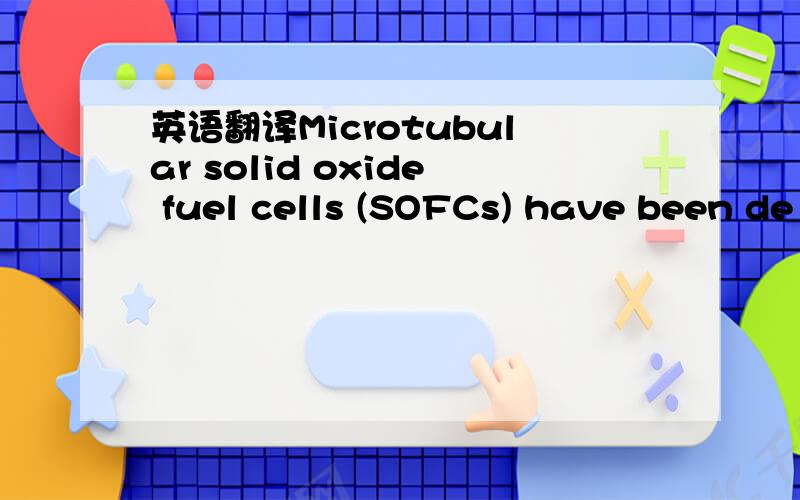英语翻译Microtubular solid oxide fuel cells (SOFCs) have been de
来源:学生作业帮 编辑:神马作文网作业帮 分类:英语作业 时间:2024/09/29 03:35:41
英语翻译
Microtubular solid oxide fuel cells (SOFCs) have been developed
in recent years mainly due to their high specifi c surface
area and fast thermal cycling.Previously,the fabrication of
microtubular SOFCs was achieved through multiple-step processes.[
1–3] A support layer,for example an anode support,is fi rst
prepared and presintered to provide mechanical strength to the
fuel cell.The electrolyte layer is then deposited and sintered
prior to the final coating of the cathode layer.Each step involves
at least one high-temperature heat treatment,making the cell
fabrication time-consuming and costly,with unstable control
over cell quality.For a more economical fabrication of micro-
tubular SOFCs with reliability and flexibility in quality control,
an advanced dry-jet wet-extrusion technique,i.e.,a phase
inversion-based coextrusion process,was developed.Using this
technique,an electrolyte/electrode (either anode or cathode)
dual-layer hollow fiber (HF) can be formed in a single step.
Generally,the electrolyte and electrode materials are separately
mixed with solvent,polymer binder,and additives to form the
outer and inner layer spinning suspensions,respectively,before
being simultaneously coextruded through a triple-orifi ce spinneret,
passing through an air gap and fi nally into a non-solvent
external coagulation bath.In the mean time,a stream of non-
solvent internal coagulant is supplied through the central bore
of the spinneret.The thickness of the two layers is largely determined
by the design of the spinneret and can be adjusted by
the corresponding extrusion rate,while the macrostructure or
morphology of the prepared HF precursor can be controlled by
adjusting coextrusion parameters such as suspension viscosity,
air gap,and flow rate of internal coagulant.The dual-layer HF
precursor obtained is then co-sintered once at high temperature
to remove the polymer binder and form a bounding between
the ceramic materials.In previous work,[4–6] a dual-layer HF
support for microtubular SOFCs,which consisted of an electrolyte
outer layer of approximately 80 μm supported by an
asymmetric anode inner layer with 35% fingerlike voids length,
was successfully fabricated using the coextrusion and cosintering
process.
Microtubular solid oxide fuel cells (SOFCs) have been developed
in recent years mainly due to their high specifi c surface
area and fast thermal cycling.Previously,the fabrication of
microtubular SOFCs was achieved through multiple-step processes.[
1–3] A support layer,for example an anode support,is fi rst
prepared and presintered to provide mechanical strength to the
fuel cell.The electrolyte layer is then deposited and sintered
prior to the final coating of the cathode layer.Each step involves
at least one high-temperature heat treatment,making the cell
fabrication time-consuming and costly,with unstable control
over cell quality.For a more economical fabrication of micro-
tubular SOFCs with reliability and flexibility in quality control,
an advanced dry-jet wet-extrusion technique,i.e.,a phase
inversion-based coextrusion process,was developed.Using this
technique,an electrolyte/electrode (either anode or cathode)
dual-layer hollow fiber (HF) can be formed in a single step.
Generally,the electrolyte and electrode materials are separately
mixed with solvent,polymer binder,and additives to form the
outer and inner layer spinning suspensions,respectively,before
being simultaneously coextruded through a triple-orifi ce spinneret,
passing through an air gap and fi nally into a non-solvent
external coagulation bath.In the mean time,a stream of non-
solvent internal coagulant is supplied through the central bore
of the spinneret.The thickness of the two layers is largely determined
by the design of the spinneret and can be adjusted by
the corresponding extrusion rate,while the macrostructure or
morphology of the prepared HF precursor can be controlled by
adjusting coextrusion parameters such as suspension viscosity,
air gap,and flow rate of internal coagulant.The dual-layer HF
precursor obtained is then co-sintered once at high temperature
to remove the polymer binder and form a bounding between
the ceramic materials.In previous work,[4–6] a dual-layer HF
support for microtubular SOFCs,which consisted of an electrolyte
outer layer of approximately 80 μm supported by an
asymmetric anode inner layer with 35% fingerlike voids length,
was successfully fabricated using the coextrusion and cosintering
process.

微固体氧化物燃料电池(SOFC)已开发近年来主要是由于其高比表面地区和快速热循环.以前,制造微固体氧化物燃料电池是通过多步过程.[1–3 ]支持层,例如阳极支撑,是第一准备和提供机械强度的预燃料电池.电解质层烧结,然后沉积之前的最后涂层的阴极层.每个步骤包括至少有一个高温热处理,使细胞制作耗时和昂贵的,不稳定控制在细胞的质量.一个更加经济制造微型—管型固体氧化物燃料电池的可靠性和灵活性,质量控制,一个先进的干喷湿挤压技术,即,一个阶段逆共挤工艺,开发.使用这技术,电解质/电极(或阳极或阴极)双层中空纤维(高频)可以形成一个单一的步骤.一般来说,电解质和电极材料分别混合溶剂,聚合物粘合剂和添加剂,形成外层和内层旋转悬浮液,分别,前同时共挤通过triple-orifi行政长官的喷丝板,通过一个空气间隙,最后到非溶剂外凝固浴.同时,一个流的非—溶剂内部混凝剂是通过中央孔在喷丝板.厚度的2层主要是确定由喷丝板的设计,可以通过调整相应的挤出速度,而宏观或形态的准备高频体是可以控制的共挤等参数调整粘度,空气间隙,和流量的内部混凝剂.双层高频前体获得然后共同烧结一次高温清除聚合物粘结剂和形式之间的边界陶瓷材料.在以往的工作中,–[46]双层高频支持微固体氧化物燃料电池,其中包括一个电解质外层是由一μ约80不对称阳极层内35%个指状空隙长度,是成功地采用共挤和cosintering过程.
英语翻译Microtubular solid oxide fuel cells (SOFCs) have been de
英语翻译Hydrogen fuel cells is a far more efficient process than
英语翻译Low-cost quasi-solid-state dye-sensitized solar cells ba
英语翻译Solid WasteSince the beginning,humankind has been genera
Process engineering and control of fuel cells,prospects for
英语翻译it’s why I’ve been focused on fuel efficient cars since
英语翻译Physicochemical characterization of nanosize zinc oxide
英语翻译Women have been discriminated against,and they have been
You have been de-registered from our system.
solid
英语翻译The nitrogen oxide concentration and the absorptioneffic
英语翻译Metal Oxide Semiconductor Field Effect TransistorsThe BJ